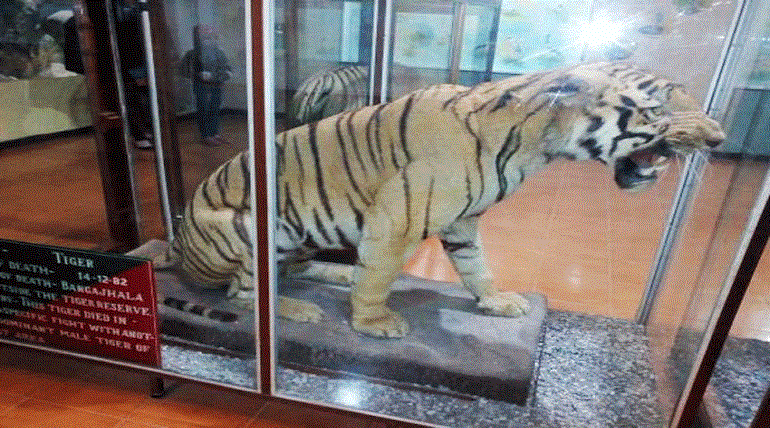
There are many facts about Jim Corbett National Park, India’s oldest national park, that are not obvious. The park was first known as Hailey National Park (in honour of Sir Malcolm Hailey, the then governor of what would become the modern-day Indian state of Uttarakhand), before getting its present name in 1957 after the British hunter-turned-conservationist Jim Corbett. The national park, established in 1936, is home to Bengal tigers as well as more than 600 species of birds (birdwatchers will rejoice) and is one of the handful of India’s tiger reserves where one can stay overnight within the park to experience what Corbett calls ‘the magic of the jungle in the silence of the stars.
Situated in the foothills of the majestic Himalayas, this park has everything from hills and rivers to marshes and grasslands. Oh, and there's also a huge lake! The diverse landscape here provides a perfect home for a wide variety of wildlife. You can spot elephants, leopards, deer, and countless species of birds. It's a paradise for nature lovers and bird watchers!
So, if you're up for an amazing adventure in nature, Jim Corbett National Park is definitely the place to be. Get ready to soak in the beauty of the park and witness some incredible wildlife. It's an experience you won't want to miss!
Jim Corbett National Park History
Jim Corbett National Park is India's oldest national park, and its history showcases a strong bond between humans and nature. Originally established in 1936 as Hailey National Park, it was named after Sir Malcolm Hailey, who was the Governor of the United Provinces at that time. However, in 1954-55, the name was changed to honor Jim Corbett, an extraordinary hunter-turned-conservationist. Jim Corbett had a deep affection for the Indian wilderness and its creatures, which inspired him to spearhead significant conservation efforts.
The Jim Corbett National Park area was the first part of a princely state named Tehri Garhwal. This region was taken over by the British in the early 19th century. The ecological importance of this place was recognized by these British administrators and they started putting up measures to preserve its biodiversity. In the early 20th century, Major Ramsay, a British official, set the groundwork for an eventual national park to be created. He helped set up the first conservation efforts ever undertaken at this site.
The subject of Corbett’s books was Jim Corbett, who was born in 1875 in the hill town of Nainital, where he grew up hunting and shooting. Corbett was best known for his expertise in locating and killing tigers and leopards responsible for mauling Indians in villages and jungles. For years, Corbett was an archetype of the Oriental hunter (along with Cecil B Boudiat’s friend Jimmie; Blanford; and Jacob), but later in his life he became a conservationist who aspired to save wildlife and their natural habitats.
It was effectively Corbett who ensured that the park came into being through his detailed grasp of this corner of India and his thoughts on conservation — he left us a number of landmark books including Man-Eaters of Kumaon (1944) — and the clearest vision for the reserves, through initial policies and infrastructure.
Conclusion
Jim Corbett National Park can also be termed a monument to the precedence of India in the conservation of wildlife, as much as it has been for the 'lasting' memory of Jim Corbett, an indomitable naturalist. But there are many lesser-known facts about this park, other than its recorded history and popularity for tiger reserve purposes. For instance, it holds one of the largest populations of crocodiles in India, especially in the Ramganga River.
Once more, the fauna section is represented by a wide diversity of bird species, making this really a heaven for ornithologists with more than 580 recorded species. What's more, the reserve played a very major role as the location for the first ever photographic record of tigers in their natural habitat—another reason which contributed much to worldwide research and awareness in the area of wildlife conservation. These two facets underline the fact that this park is not only a habitat for large mammals but a complete ecosystem ranging from various life forms.
That is to say, the rich history of this beautiful place, coupled with resplendent biodiversity, makes Jim Corbett National Park an area of immense interest and significant natural treasure.
FAQs
1. When was Jim Corbett National Park established?
It was established in 1936, originally under the name Hailey?National?Park. Solluna Resort+1
2. Why was it initially named “Hailey National Park”?
The park’s original name honoured Sir?Malcolm?Hailey, who was the Governor of the then United Provinces under British rule. Solluna Resort
3. When and why was the name changed to Jim Corbett National Park?
The park was renamed in 1957 (or about 1954-55) in honour of Jim?Corbett, the hunter-turned-conservationist who played a key role in its establishment and wildlife protection efforts. Solluna Resort+1
4. What territory or region was the park originally part of?
The area was part of the princely state of Tehri?Garhwal, and later came under British administration in the early 19th century. Solluna Resort
5. Who laid the groundwork for creating the park?
Beyond Jim Corbett’s involvement, a British official known as Major?Ramsay (in the early 20th century) initiated conservation efforts in this area, which later led to formal establishment of the park. Solluna Resort
6. What significance does the park hold in terms of conservation history in India?
-
It is India’s oldest national park. Solluna Resort+1
-
It stands as a landmark in Indian wildlife conservation, especially for protecting the Bengal tiger and diverse ecosystems. Solluna Resort
7. What ecosystems or landscapes did the park encompass upon its creation?
From the article: the park sits in the foothills of the Himalayas and includes hills, rivers, marshes, grasslands and forests — providing a rich variety of habitats. Solluna Resort
8. Are there any noteworthy “firsts” associated with the park?
Yes — for example, it was one of the first reserves where the tiger was photographed in its natural habitat (according to the article). Solluna Resort
9. What role did Jim Corbett himself play in the establishment of the park?
Jim Corbett was a hunter early in his life, but later he turned to conservation, documenting man-eaters and helping to protect wildlife — his deep knowledge of the region and advocacy helped make the park’s creation possible. Solluna Resort+1
10. Why is the park important today?
Because it preserves a significant portion of India’s natural heritage, provides habitat for many species (including tigers), and stands as a symbol of the shift from hunting to conservation in India. Solluna Resort




















